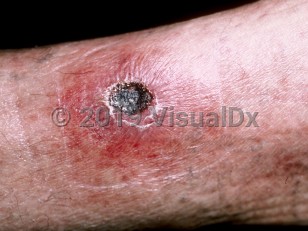Rickettsialpox in Adult
Alerts and Notices
Important News & Links
Synopsis

Rickettsialpox is a febrile, infectious disease caused by Rickettsia akari, which is transmitted to humans by the painless bite of house mouse mites (Liponyssoides sanguineus). It was first described following a 1946 outbreak in New York City and was termed rickettsialpox due to its resemblance to chickenpox. There is a higher occurrence of rickettsialpox in urban areas, with documented cases confirmed in the United States, Croatia, Mexico, South Korea, South Africa, Canada, and parts of Russia.
The bite follows a 10- to 24-day incubation period, after which an eschar at the site of the mite bite appears (1 of 7 patients will have multiple eschars), followed by fever, nontender regional lymphadenopathy, headache, photophobia, and anorexia 2-7 days later. The clinical course of the disease lasts 2-3 weeks and is generally self-limited. A persistent headache and lassitude can last for weeks following the acute illness. No deaths clearly attributable to rickettsialpox have been reported to date.
The bite follows a 10- to 24-day incubation period, after which an eschar at the site of the mite bite appears (1 of 7 patients will have multiple eschars), followed by fever, nontender regional lymphadenopathy, headache, photophobia, and anorexia 2-7 days later. The clinical course of the disease lasts 2-3 weeks and is generally self-limited. A persistent headache and lassitude can last for weeks following the acute illness. No deaths clearly attributable to rickettsialpox have been reported to date.
Codes
ICD10CM:
A79.1 – Rickettsialpox due to Rickettsia akari
SNOMEDCT:
75096007 – Rickettsialpox
A79.1 – Rickettsialpox due to Rickettsia akari
SNOMEDCT:
75096007 – Rickettsialpox
Look For
Subscription Required
Diagnostic Pearls
Subscription Required
Differential Diagnosis & Pitfalls

To perform a comparison, select diagnoses from the classic differential
Subscription Required
Best Tests
Subscription Required
Management Pearls
Subscription Required
Therapy
Subscription Required
References
Subscription Required
Last Reviewed:01/24/2024
Last Updated:01/25/2024
Last Updated:01/25/2024

